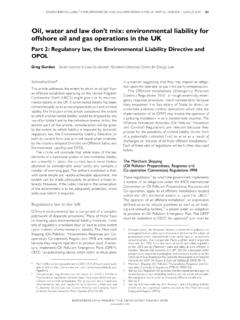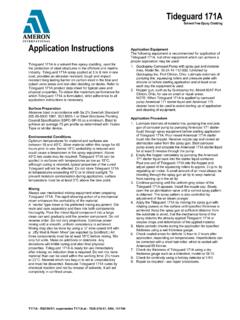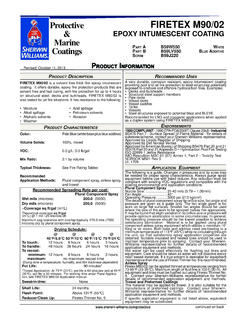Transcription of Health & Safety Report 2017 - Oil & Gas UK
1 Health & Safety Report 2017 @oilandgasukOil & Gas UK3 Contents1. Foreword 52. Key Findings 63. 2016 Performance 8 Health 10 Personal and Process Safety 12 Operator Safety Performance Benchmarking 20 Asset Integrity Performance Indicators 244. Offshore Helicopter Operations 27 Overview 28 Current Helicopter Types 29 Offshore Helicopter Reportable Accidents on the UK Continental Shelf 30 Accident Analysis 315. Significant Issues and Activities 336. Glossary 39 Health & Safety Report 20174 Health & Safety Report 2017 The UK Oil and Gas Industry Association Limited (trading as Oil & Gas UK) 2017 Oil & Gas UK uses reasonable efforts to ensure that the materials and information contained in the Report are current and accurate. Oil & Gas UK offers the materials and information in good faith and believes that the information is correct at the date of publication.
2 The materials and information are supplied to you on the condition that you or any other person receiving them will make their own determination as to their suitability and appropriateness for any proposed purpose prior to their use. Neither Oil & Gas UK nor any of its members assume liability for any use made ForewordWelcome to the 2017 Oil & Gas UK Health & Safety Report , which documents the major trends, issues and themes relating to our sector s Health and Safety performance in , the industry saw a fatality offshore last year. Investigations continue but the lessons learnt from the accident, which occurred during the unpacking of an offshore container, will be shared across the sector. Such incidents serve to remind us that whatever we are doing, we can never be , the data published in this Report does go some way to reinforce that industry is retaining its focus as it demonstrates improving overall performance in offshore Safety .
3 There has been a further reduction in the sector s three-year rolling average, non-fatal injury rate where UK oil and gas remains lower than other comparable industrial sectors, such as construction, manufacturing, and transport and storage. The over-seven-day injury rate in 2016 was the third lowest since this measure was first calculated in 1996, while the specified injury rate has fallen by over 40 per cent since 2013. Similar positive trends are reported in process Safety , where dangerous occurrences such as hydrocarbon releases, dropped objects, and fires and explosions must by law be reported to the Health and Safety Executive. Last year, the number of dangerous occurrences was the lowest on record, 62 per cent lower than the 2000-01 peak. Prevention of hydrocarbon releases remains an industry priority and the overall downward trend seen over the last decade has been sustained. In 2016, the number of major and significant process releases, which are those with the potential to escalate, was the lowest on record.
4 Good progress is also being made in reducing the backlog in Safety -critical maintenance, which is essential to the integrity of our offshore assets. The industry s work to improve Safety performance is delivering. However, we need to maintain focus and strengthen collective determination to drive further improvement. Any queries on content or feedback should be directed to Mick Borwell, Oil & Gas UK s Health , Safety and environment policy director, on Mick Borwell, Health , Safety and Environment Policy Director, Oil & Gas UK56 Health & Safety Report 20172. Key FindingsPersonal Safety Performance Tragically, there was a fatality on the UK Continental Shelf (UKCS) in 2016 during unpacking of an offshore container. The official investigation is ongoing and lessons that can be learnt from this incident will be shared with industry. The industry s three-year rolling average, non-fatal injury rate per 100,000 workers continues to improve from 430 in 2015 to 415 in 2016.
5 The rate remains lower than other comparable industrial sectors in the UK such as manufacturing, transport/storage and construction. 2016 saw the third lowest over-seven-day injury rate since the measure was first calculated in 1995-96 at 301 per 100,000 workers. Strains and sprains remain the most common type of injury. The specified injury rate decreased to its lowest recorded level to 73 per 100,000 workers last year. This is a decline of 43 per cent from 2013 when the relevant RIDDOR1 reporting categories were revised. The UKCS lost time injury frequency (fatalities and lost work day cases per million man-hours) remains below the European average for offshore operations at incidents per million man-hours in Safety Performance Dangerous occurrences such as hydrocarbon releases (HCRs), fires or explosions, and dropped objects are at their lowest on record at 292 in 2016.
6 This is 62 per cent lower than the 2000-01 peak. Dropped objects are the most frequent, constituting 20 per cent of all reports of dangerous occurrences closely followed by HCRs at 18 per cent. There has been a sustained downward trend in the total number of process HCRs (produced hydrocarbon releases) since a peak in 2004. The number of major and significant process releases, those with the potential to escalate, have been reducing since before 2000 and, in 2016, the numbers reported were the lowest on record and less than 20 per cent of those reported in 1997. The total number of Safety -critical maintenance hours in backlog has declined since the peak in 2014. The total number of open level 3 verification non-compliance findings has remained consistent at around ten. The number of overdue findings is showing a steady decline and is at its lowest since reporting Reporting of Injuries, Diseases and Dangerous Occurrences Regulations 2013 (RIDDOR).
7 7 Operator Safety Performance Benchmarking Performance overall for the 32 participating installation operators is encouraging; the rates of dangerous occurrences and reportable injuries last year are below the ten-year average for the group. Dangerous occurrence frequency per million man-hours for these installation operators is at a historical low at Reportable injury frequency for these installation operators increased from in 2015 to in 2016, but it is still lower than any other year in the last decade. There were more operators (six) in 2016 with no dangerous occurrences than in any other year since benchmarking began in 2006. Nine operators experienced no reportable injuries in 2016, against an average of six in the preceding decade. Offshore Helicopter Operations Thirteen offshore workers tragically lost their lives in an accident involving a Super Puma Airbus EC225LP helicopter in the Norwegian North Sea in April 2016.
8 Although the European Aviation Safety Agency cleared this helicopter type to fly, the Norwegian and UK Civil Aviation Authorities suspended flights by this model pending further investigation and testing2. After almost three accident-free years, a non-fatal accident occurred on the UKCS in 2016, increasing the UKCS five-year average all accident rate from to per 100,000 flying hours. At the end of 2016, the UKCS active helicopter fleet numbered 65 aircraft and comprised a mix of airframe types, including Sikorsky S92, AH175 and AW189 helicopter types to replace the suspended Super Pumas (H225 and AS332L2).2 As Oil & Gas UK went to print with this Report , the flight suspension was lifted for UK and Norwegian operations. 2 ECONOMIC Report 20168In Summary It is important to manage the Health and well-being of the offshore workforce effectively, given the remoteness of the worksite and the often demanding nature of the work they perform.
9 A suite of occupational Health -related legislation regulates the offshore working environment to ensure that risks to Health are controlled. In addition, it is industry policy that all persons working offshore are examined regularly by a medical professional and deemed medically fit for work before travelling offshore. The Oil & Gas UK medical guidance and the registered examining doctors who conduct assessments in line with this guidance help to ensure that the workforce is medically fit for work UK offshore oil and gas industry is also committed to protecting people, the natural environment and assets by maintaining safe operations. The industry continually strives to improve personal and process Safety , using performance indicators to monitor how well this is being managed. Personal Safety metrics point to industry s performance in managing risks to an individual. However, to minimise harm to people, the primary focus for a major hazard industry must be on process Safety , and the effective containment of hydrocarbons and the associated hazards.
10 Health & Safety Report 20173. 2016 Performance The three-year average non-fatal injury rate is less than half that of construction and transportThe over-seven-day injury rate in 2016 was the lowest on record The specified injury rate is at its lowest recorded levelMaintenance backlog is being tackled by industryYear-on-year reductions reportedAs a precautionary measure, Super Puma flights were suspended following the fatal accident in NorwaySince 2004, the number of process hydrocarbon releases maintains a downward trendDangerous occurrences are at their lowest: lower than the 2000-01 peakThere was one reportable non-fatal helicopter accident on the UK Continental Shelfin 2016 Health & Safety Report 2017 - Facts and Figuresoilandgasuk/healthandsafetyreport Over 715,000 passengers were flown offshore in 2016totalling nearly 89,000 flight hours3rd62% The three-year average non-fatal injury rate is less than half that of construction and transportThe over-seven-day injury rate in 2016 was the lowest on record The specified injury rate is at its lowest recorded levelMaintenance backlog is being tackled by industryYear-on-year reductions reportedAs a precautionary measure, Super Puma flights were suspended following the fatal accident in NorwaySince 2004, the number of process hydrocarbon releases maintains a downward trendDangerous occurrences are at their lowest.








